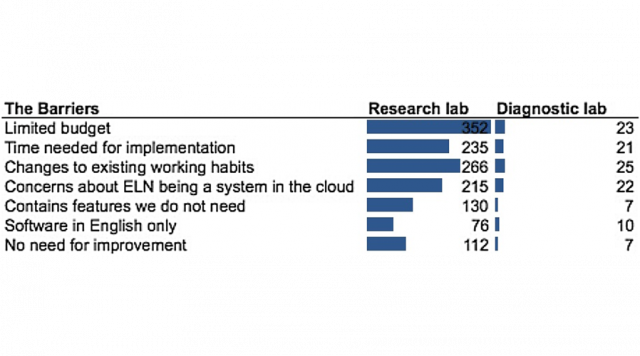Barriers to Electronic Lab Notebook adoption

Our lab has been interested in electronic lanb notebooks (ELNs) for a while. A recent publication in the Journal of Cheminformatics has focused on the barriers to ELN adoption. Especially in the academic world, more than 90% of scientists are still using the traditional paper lab notebook. Biggest barrier to adoption was the cost in terms of money and learning of new habits. Close runner-ups on places 3 and 4 were the implementation effort and security concerns. While the authors are clearly biased (they are developing the open source ELN ELN SciNote), the barriers to adoption are the same that I experience in my lab and at the University of Helsinki.
I was stunned when about 2 months ago I received an e-mail with the news that the University of Helsinki had negotiated a framework agreement with the LabVantage LIMS/ELN vendor Software Point. While I think a university-wide ELN solution is necessary, this deal seems anything but optimal for most research-oriented laboratories at the University of Helsinki. Several labs at the university are using ELNs already for a while and none of them have been aware of the efforts to provide a university-wide agreement for a LIMS/ELN solution. And none of those that already use a LIMS/ELN have been choosing LabVantage, but other solutions (Labguru, SciNote, eLabFTW). It would have been helpful to have somebody in the evaluation team, who has actual experience with LIMS/ELNs use (or somebody who has participated in LIMS/ELN development), especially since such expertise exists at the University of Helsinki.
Only a few people have been involved in the negotiations while the majority of the stakeholders were not even asked for their input. When I asked explicitly about this secluded operation, the answer was: Very few units (mainly the chronology unit and a person from dept of chemistry) were involved with the purchase at the time even though the information was spread around the university and anyone was welcome to participate and state their needs. However, even though I try to actively follow the IT infrastructure developments, I did not see any announcements anywhere and also searching retrospectively, I could not find anything that would have alerted me and allowed me to participate. The labs contributing most to the international success of Helsinki University are the main stakeholders, but they were ignored. Maybe a little bit more active search for the stakeholdres would have been appropriate.
The base package that was negotiated with LabVantage seems to be geared towards routine and clinical lab work, but not towards innovative research. Among the two modules that are mostly necessary for life science research work are the ELN and the storage management. Unfortunately, many life-science specific routines (searching for DNA and protein sequences with blast-like search algorithms) are totally absent from the offer, but are very much needed for life science. The lack of a free API (like eLAbFTW features or SciNote soon will feature) prevents users from incorporating their own, existing code or their own database systems. Every small change would require to involve the LabVantage developers and that will be a very slow and costly process. In reality, this means that shortcomings of the system will never be addressed. The base package can be taken into use by any lab at the university after a single payment of 200€ for each user (no floating licenses, only dedicated users). For our lab that would amount to 2000€, but a low price tag is not a selling point in itself.
Within the framework agreement, any lab can pay for the additional modules on its own, but the heft price tag of 17500€ make it unlikely that anybody will do so. I am unwilling to lobby for a joint purchase, because there is no way of knowing, whether these modules would be suitable for everyday lab work. Unlike most other vendors, LabVantage doesn't offer a free trial of the system. It makes me suspicious, if a vendor doesn't offer a trial. If the product is good, a trial will convince potential customers to buy. If the product is good, what could be the downside of a trial for the vendor?
We have ourselves tested several ELN solutions over the last two years and some systems received very bad feedback by those people who use them every day (e.g. cumbersome data import, unintuitive interface, slow server responses). As a matter of fact, for oligonucleotide management and protein/enzyme storage, we still use the absolutely outdated open source LIMS that I co-authored about 15 years ago as a PhD student (http://phplabdb.sourceforge.net, now at https://github.com/mbekaert/phplabdb). In my lab, we use eLabFTW. We have a local installation on the Helsinki University intranet (which can be accessed via VPN from everywhere) and anybody from Helsinki University can get an account there. If you are interested in trying it out, please contact me!
The key question remains unanswered: Why were the majority of stakeholders not pulled into the decision-making process?



